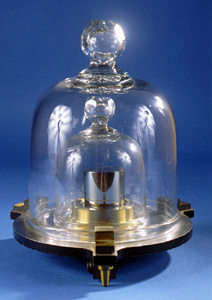Standards of Length, Mass, and Time: Newtonian Physics Lecture Series Lecture 1: Chapter 1 Section 1
Before we get into actual Physics, commentary must first be made about the foundations of all science, including physics. The fundamental basis for all physics is the concept of units. After all, when I say "The speed is 6", that is meaningless. Am I talking about m/s, km/hr., miles/hr, knots? Which units am I using?
There is a system of measurement which has been around for centuries, but has been globally standardized for use in science since 1960. This system is called the Système international from the French, who was the first to widely adopt the concept shortly after their Revolutionary War against Britain. The shorthand for this system is SI, and the fundamental units it uses for classical mechanics is the meter, the second, and the kilogram. There are other fundamental units in Classical Physics, but those deal with either electricity or waves, and since those are covered in their own separate semesters, I'll cover those fundamental units for those semesters lecture series.
Length (meter) is defined as the distance between two points in space. It's unit, the meter, is defined as the distance traveled by light in a vacuum in 1/299,792,458ths of a second by the SI system. This seems to be an arbitrary fraction, but in reality, it is an artifact of the fact that scientists wanted to change the definition of the meter from an arbitrary definition to a definition based exclusively on a universal constant without actually changing the length of the meter.
Time is defined as the distance between two events occurring. Its unit, the second, is defined as exactly 9,192,631,770 times the vibrational oscillation of radiation from the Cesium-133 isotope. Again, this seems arbitrary, but oce again, this stems from the desire to switch from an geocentric definition to a truly Universal definition based upon a physical property which would be observable literally everywhere in the universe without changing the duration of the second.
The mass of an object is defined as the macroscopic amount of material in an object, independent of specific material. Its unit, the kilogram, is the only fundamental unit not currently based on a universal physical property, but that's looking to be changed soon. As it presently stands, the kilogram is defined by a certain specific well-machined weight made of an alloy of 10% iridium and 90% platinum being held under lock and key at the International Bureau of Weights and Measures in Sevres, France. Talk about arbitrary.
These are the three fundamental units. We can add prefixes to these units to indicate factors of 10. For example, a millimeter is 1/1000th the size of the meter and the kilometer is 1000 times the size of the meter. Other units are derived units, such as volume. The liter is derived from the cube of the meter.
If you have any questions, please leave them in the comments. Next time, I will be covering the concept of Models in Physics. Until then, stay curious.
To help get this lecture series come out with higher frequency, please donate to The Science of Life. This helps keep the information current and allows me to dedicate more time to this project instead of obtaining money through external means.
←Previous Chapter 1 Physics Other Lecture Series Next→
There is a system of measurement which has been around for centuries, but has been globally standardized for use in science since 1960. This system is called the Système international from the French, who was the first to widely adopt the concept shortly after their Revolutionary War against Britain. The shorthand for this system is SI, and the fundamental units it uses for classical mechanics is the meter, the second, and the kilogram. There are other fundamental units in Classical Physics, but those deal with either electricity or waves, and since those are covered in their own separate semesters, I'll cover those fundamental units for those semesters lecture series.
Length (meter) is defined as the distance between two points in space. It's unit, the meter, is defined as the distance traveled by light in a vacuum in 1/299,792,458ths of a second by the SI system. This seems to be an arbitrary fraction, but in reality, it is an artifact of the fact that scientists wanted to change the definition of the meter from an arbitrary definition to a definition based exclusively on a universal constant without actually changing the length of the meter.
Time is defined as the distance between two events occurring. Its unit, the second, is defined as exactly 9,192,631,770 times the vibrational oscillation of radiation from the Cesium-133 isotope. Again, this seems arbitrary, but oce again, this stems from the desire to switch from an geocentric definition to a truly Universal definition based upon a physical property which would be observable literally everywhere in the universe without changing the duration of the second.
The mass of an object is defined as the macroscopic amount of material in an object, independent of specific material. Its unit, the kilogram, is the only fundamental unit not currently based on a universal physical property, but that's looking to be changed soon. As it presently stands, the kilogram is defined by a certain specific well-machined weight made of an alloy of 10% iridium and 90% platinum being held under lock and key at the International Bureau of Weights and Measures in Sevres, France. Talk about arbitrary.
 |
| Shiny |
If you have any questions, please leave them in the comments. Next time, I will be covering the concept of Models in Physics. Until then, stay curious.
To help get this lecture series come out with higher frequency, please donate to The Science of Life. This helps keep the information current and allows me to dedicate more time to this project instead of obtaining money through external means.
←Previous Chapter 1 Physics Other Lecture Series Next→

Comments
Post a Comment